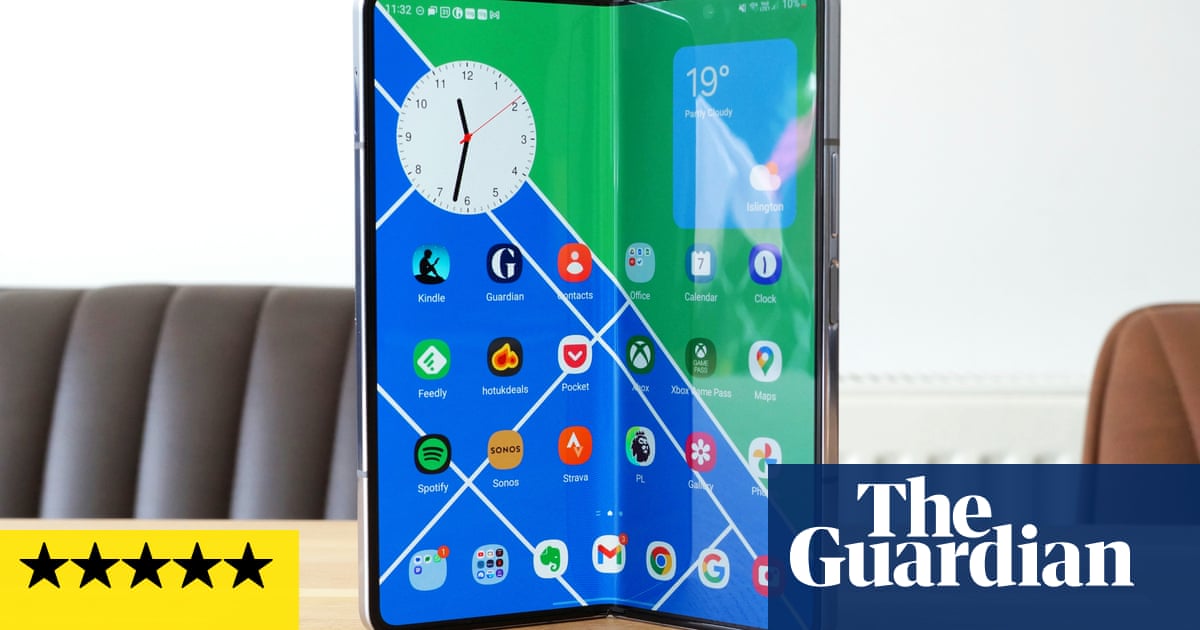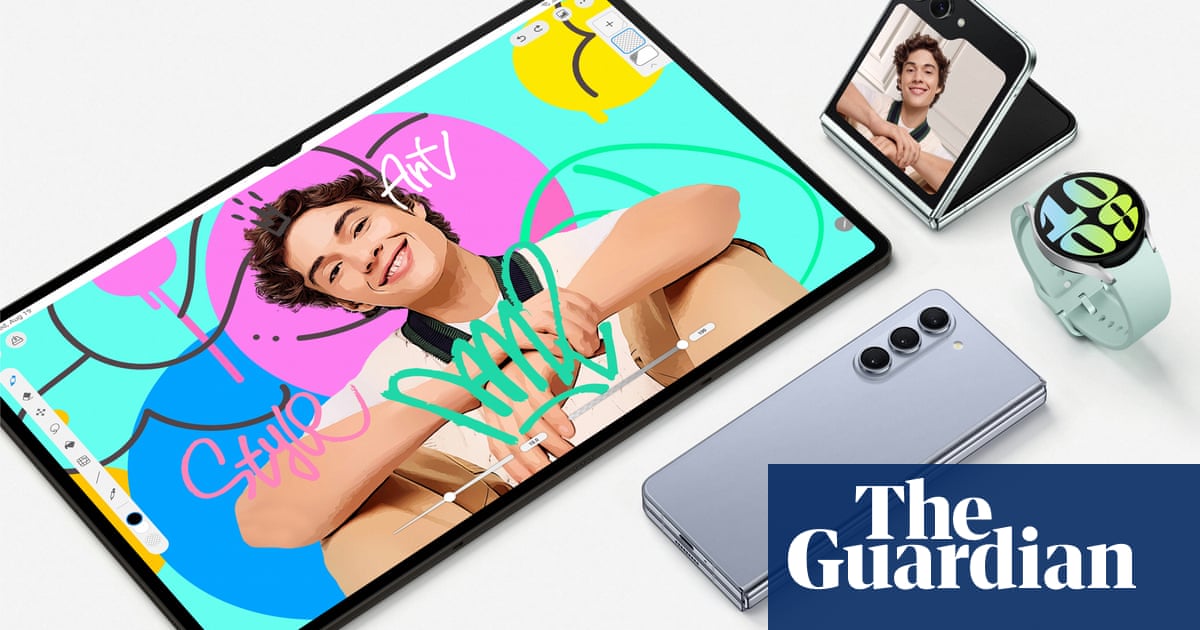
Samsung’s cutting-edge Galaxy Z Fold 4 Android phone-tablet hybrid is back and here to prove that folding devices are the future.
By putting both a powerful smartphone and 7.6in tablet in your pocket, Samsung has created the device of choice for gadget lovers. But the price means it is not ready yet for most consumers.
Its folding form, five cameras and two screens should tell you this isn’t a normal phone, instead being the most advanced glimpse at the evolution of the humble smartphone.
The bleeding-edge tech makes the Fold 4 one of the most expensive devices you can buy at £1,649 ($1,799/A$2,499) – roughly the same price if you bought a premium phone and a tablet separately but more than most should ever pay for a pocket computing device.
The general look is similar to last year’s first version, with small refinements all round. The metal sides are flatter with a premium, lustrous finish. The device is shorter and the hinge is thinner, making the outside screen wider. It feels more like a regular phone for messaging and calls when closed, albeit a chunkier and heavier one.
Open it like a book for the large, tablet-sized 7.6in flexible OLED screen, still very much a quasi-magical experience. The display is big, bright, smooth and feels slightly harder under your finger than the first version. Samsung says the screen is 45% more durable than last year but I would still keep it away from children as it simply isn’t as robust as traditional hardened glass.
There’s still a crease along the fold, which you can feel with your finger and see at an angle. It would be better if it wasn’t there but you won’t notice it within a few minutes of using the device. The under-display camera is slightly better hidden, too, so you won’t see it day-to-day unless specifically looking for it.
The hinge holds the display open at any angle, shutting with a satisfying snap. The main display is great for videos, games, reading sites and books, or multitasking with two or more apps open at the same time.
Specifications
Main screen: 7.6in QXGA+ 120Hz Amoled flexible display (374ppi)
Cover screen: 6.2in HD+ 120Hx Amoled (387ppi)
Processor: Qualcomm Snapdragon 8+ Gen 1
RAM: 12GB of RAM
Storage: 256, 512GB or 1TB
Operating system: One UI 4.1 based on Android 12L
Camera: 50MP wide, 12MP ultrawide, 10MP 3x telephoto; 10MP and 4MP selfie cameras
Connectivity: 5G, dual sim, esim, USB-C, wifi 6E, NFC, Bluetooth 5.2
Water resistance: IPX8 (1.5 metres for 30 minutes)
Dimensions folded: 155.1 x 67.1 x 15.8mm
Dimensions unfolded: 155.1 x 130.1 x 6.3mm
Weight: 263g
Faster, smoother and longer lasting
The Fold 4 is super snappy and smooth with Qualcomm’s latest top processor, the Snapdragon 8+ Gen 1, which is the most powerful chip available on Android, as used by the Flip 4 and the OnePlus 10T.
The phone’s two screens make its battery life more variable than a regular phone. When mostly using only the large, inside display, the battery lasts a good 35 hours between charges. More balanced use of the two displays for a mix of messaging, multitasking and media consumption results in it lasting for about 40 hours, including actively using the screens for up to seven hours. This is very good indeed and a large step up on its predecessor.
The Fold 4 takes about 80 minutes to fully charge, hitting 50% in 30 minutes using a 25W or greater USB-C power adaptor (£11.90 from Samsung), which is not included.
Sustainability
Samsung does not provide an expected lifespan for the battery but it should last in excess of 500 full charge cycles with at least 80% of its original capacity. The phone is generally repairable, and the battery is replaceable by authorised service centres in the UK. Inner, larger, display repairs cost £539. The screens are covered under warranty for two years but Samsung evaluates breakages for “evidence of product misuse” and may charge a fee for repairs. Insurance is recommended, costing £8.49 a month from Samsung or available from third parties.
Several internal components are made from 20% recycled nylon or plastic. Samsung offers trade-in and recycling schemes for old devices. The company publishes annual sustainability reports but not impact assessments for individual products.
Better software
The Fold 4 runs a new version of One UI 4.1 based on Google’s Android 12L software, which is specifically designed for tablet and folding-screen devices.
Most of the upgrades within Android 12L are behind the scenes to make apps work better when multitasking and switching forms. The new taskbar is great, acting like a dock for quickly getting to your most-used apps and putting them in split-screen mode by dragging and dropping from it.
Using a pair of apps on a screen roughly the size of two phones side by side is remarkably powerful and enables things I would usually reach for a laptop to do, such as budgeting, meal planning and comparison shopping. Most apps are stable and work great in various combinations. Rotating the Fold 4 to landscape gives you dual-pane views in some apps too, including Gmail, so you can see your inbox on the left and a reading pane on the right.
Cameras
The Fold 4 has five cameras in total: a new triple system on the back, a 10MP selfie camera on the front and an additional 4MP selfie camera hidden under the top right of the internal screen.
The back cameras are essentially the same as those fitted to the S22+ and are a marked upgrade on the Fold 3 from last year. The main 50MP camera is great, capturing excellent images in a variety of lighting conditions with very good low-light performance. The 3x optical zoom is useful and the ultrawide camera is good for landscapes and group shots.
Video shot by all three is very good, too, but the ultrawide is limited to 30 frames a second for some reason.
The under-display selfie camera is novel but of poor quality for photos, so only good enough for video calls. The outside 10MP selfie camera is one of the best but you can shoot much better selfies and group shots with the main cameras using the outside screen as a viewfinder. It is a little awkward to hold but worth the effort.
Overall, the cameras on the Fold 4 now match all but Samsung’s top S22 Ultra cameraphone, making them some of the very best on the market.
Price
The Samsung Galaxy Z Fold 4 costs £1,649 ($1,799/A$2,499) with 256GB of storage.
For comparison the Galaxy Z Flip 4 costs £999, the Galaxy S22 Ultra costs £1,149, the Galaxy S22+ costs £949, the Microsoft Surface Duo 2 costs £860, the Google Pixel 6 Pro costs £649, and the Apple iPhone 13 Pro Max costs £1,049.
Verdict
Samsung’s cutting-edge folding phone-tablet hybrid has lost none of its novelty and power for its fourth generation.
The Galaxy Z Fold 4 is unrivalled outside China, where some local brands make similar devices for the local market. Lots of small refinements add up in this new iteration. The Fold 4 is easier to use as a phone for messaging and calls when closed. Opening it up like a book for the beautiful, large internal screen is still magic, as is shutting it to put it into standby with a snap.
Software upgrades have made multitasking a lot easier and more robust, while the big screen is excellent for watching TV shows on the go when you need to unwind. Longer battery life and a fast chip are welcome, as are the significant upgrades to the camera, bringing the Fold in line with Samsung’s top regular phones.
The drawback is simple – the price. One day a folding phone-tablet might be a realistic prospect for the mass market but for now the Fold 4 is still too costly and too fragile. It is a gadget-lover’s dream and the most exciting device currently on the market. But for most people a regular flat phone or the novel Z Flip 4 is a better buy.
If you must have the most advanced device available, the Z Fold 4 is it. Just don’t let your kids anywhere near it and buy insurance in case the worst happens.
Pros: a phone and tablet in one, water resistance, powerful split-screen apps, phone-like outside screen, fantastic tablet screen, top performance, very good battery life, excellent cameras, head-turning design.
Cons: extremely expensive, more fragile than a regular device and internal screen can be marked more easily than traditional glass, costly to repair, no dust resistance, heavy, thick, not a massive leap over the previous generation.












